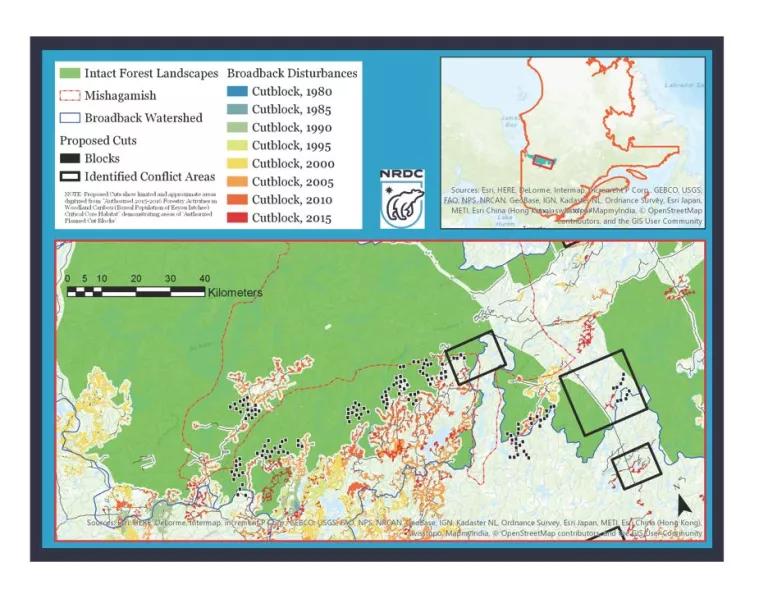
This blog was written by Jennifer Skene
In less than four months, Quebec will allow logging trucks to invade the Waswanipi Cree’s last intact forest, undermining the government’s decades of promises to the Cree. For fifteen years, the Waswanipi Cree have waged a battle to protect the Broadback River Valley forest, which they call the Mishigamish, from the logging that has degraded 90% of their territory. This logging, in part fueled by demand for forest products from the United States, is now threatening the last 10% of intact forest the Waswanipi have left. This year, Quebec released a logging plan that will expand logging into the Mishigamish beginning in 2019; already logging roads are inching closer to the Waswanipi Cree’s proposed protected area. In protest, the Waswanipi community staged a peaceful demonstration today at the junction of a highway and a logging road leading into their territory. The culmination of fifteen years of frustration, the Waswanipi Cree’s demonstration is a condemnation of Quebec’s broader failure to respect the Cree’s calls for protection and rights to their land. It is a call to stop logging in the Mishigamish before it is too late.
The Mishigamish lies in the Broadback River Valley Forest. With old-growth forests that still teem with wildlife such as caribou, marten, and moose, and freshwater that is among the purest in the world, the Mishigamish is irreplaceable, both culturally and ecologically. Here, the Cree have lived off the land for millennia. As former Waswanipi Youth Chief Melanie Neeposh described, “Our culture’s out there on the Broadback. Our identity’s out there on the Broadback.” Don Saganash, a tallyman for the Waswanipi Cree, explained, “We do not ask much, it’s just a small space, but part of our way of life.” He added, “This is our territory, it’s us.” As a tallyman, Saganash manages one of Waswanipi’s 62 traplines, or hunting areas. With only three of these traplines left undegraded, the loss of this last intact forest would be devastating for the Cree way of life.

Waswanipi’s repeated requests for protection of the Mishigamish have fallen on deaf ears. While Quebec has protected some areas of Eeyou Istchee, the Cree homeland, these protections are far from sufficient, and, as Waswanipi Chief Marcel Happyjack stated, “[don’t] protect what should really be protected.” In 2015, Quebec committed to having “meaningful discussions” with the Waswanipi on protecting the Mishigamish. Yet Quebec only met with the Waswanipi once, three years ago. Instead, in 2018 Quebec finalized a five-year logging plan that expands logging into the Mishigamish, which is set to start in 2019.
The five-year logging plan not only contravenes Quebec’s 2015 promise to negotiate with the Waswanipi, but also undermines the province’s commitments under the 2002 Paix des Braves agreement to protect wildlife areas important to the community. It is also antithetical to the 1975 James Bay and Northern Quebec Agreement, which commits Quebec to protecting “the Cree people their economies and the wildlife resources upon which they depend.” Canada has now fully committed to the United Nations Declaration on the Rights of Indigenous Peoples, which protects Indigenous land rights. Quebec, in approving logging in the Mishigamish, is showing itself to be a human rights laggard.


Roads are the first symptom of the coming logging onslaught. In anticipation of the availability of new logging areas, companies are building more access roads, which are further fragmenting the forest and—quite literally—paving the way for more development. EACOM Timber Corporation, for example, is graveling a road to enable them to remove 250,000m3 of wood allocated to them in the five-year plan.
Given the ongoing road construction, the Waswanipi Cree cannot wait any longer for Quebec to come to the table. Through this demonstration, the Waswanipi Cree are bringing their demands to the public and highlighting their frustration with their treatment by Quebec. Supported by Cree communities across Eeyou Istchee, the demonstration is a message to Quebec that the Broadback is not for sale. Saganash explained, “We want to send a message to the world. We are not against a law or a company in particular; we just want to protect our territory from [industrial] exploitation.”
The Cree are not alone in calling for Quebec to protect intact forest and Indigenous ways of life. Much of the degradation of the Mishigamish is driven by international marketplace demand, particularly in the United States. Over half of all Quebec’s forest products are exported, and of these exports, more than 80% end up in the United States. Given the U.S. marketplace’s role in driving logging in Quebec, companies including the Gap, Amy’s Kitchen, and Ben & Jerry’s have urged Quebec and other provinces to implement protections to ensure forest products are not coming at the expense of old-growth forests, species like caribou, and Indigenous Peoples.
The Waswanipi demonstration is a vital stand by a community fighting to prevent the sacrifice of their territory for domestic and international demand for tissue, lumber, and newsprint. Roads are the first tendrils of development creeping into and eroding the intact forests of the Mishigamish. If Quebec’s complacency continues, there will be more, pushing further and further into the last undisturbed forests of Eeyou Istchee and opening more of the land to destructive logging. It is urgent that the next Quebec government finally live up to its decades of commitments. As Saganash noted, “Foresters have already taken 90%, so we want to save what’s left for the next generation.”
